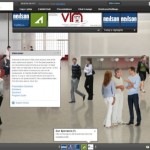I imagined that during my first virtual trade show I’d sort of feel like the sci-fi movie character Tron, mesmerized and captive in some digital man-made construct that has drawn me down to the minute level of electric impulses carrying the very bits and pieces of information I was there to seek.
Actually, the “lobby” was a bit eerie. In total silence there were still images of people speaking to one another, their likenesses partially covered over by pull-down boxes, scrolling text and menu bars.
“Welcome to VIM 2013” inched right to left across the screen, and above that message the names and logos of exhibitors spun like slot machine:
“Calvary,” “BTIS,” “Neilson,” “Fastrack,” “Personable,” “Arrowhead.”
I did feel captive at first. I was at, or rather in, a tradeshow I had committed to attending with the goal of writing this story. That feeling quickly gave way to the satisfaction of knowing that I didn’t have a suit and tie to don before driving to some convention center through stop-and-go traffic to downtown somewhere and pay $20 to park on Level 8 of a behemoth concrete maze.
Upon that recognition, a feeling of freedom set in.
The two-day 2013 Virtual Insurance Marketplace tradeshow on May 29 and May 30 was one of several online tradeshows in the works from host Fairfield, Calif.-based Direct Connection Advertising & Marketing LLC.

According to Direct Connection owner Anita Nevins, since she started hosting virtual tradeshows three years ago interest in them has gradually picked up, particularly as businesses continue to look for ways to better communicate and keep down expenses like employee travel.
“There’s definitely a trend where companies are becoming more interested in it,” Nevins said.
Nevins earns a profit based on the size of the show, charging exhibitors to cover her expenses and the cost of a software license.
“This one was a break even for me,” she said. “However, an association could potentially use a virtual event as a profit center again depending on the number of exhibitors and sponsors they have.”
Exhibitor booths at VIM 2013 were $850 for new, or $650 for previous exhibitors. That’s slightly more than half what booths at a physical trade show cost.
“I just ran the numbers for five current physical shows and the average is $1,359 for an exhibit booth – plus travel and time out of the office for usually multiple staff,” Nevins said.
Nevins doesn’t envision that the virtual concept will replace physical tradeshows, but she believes virtual tradeshows can support their physical cousins and reach out to a different audience.
“My experience with the annual tradeshow circuit is that, for the most part, the same people attend year after year,” she said. “So the question I had was, ‘How can you reach the agents/brokers that don’t come to physical tradeshows?’ I also think that companies with larger budgets can make a bigger showing at physical tradeshows, which can be hard for exhibitors with limited budgets to compete for the attendees’ attention.”
The next Virtual Insurance Marketplace, or VIM, won’t be held until next year, but Nevins said she’s been talking with several large carriers and agencies about creating their own tradeshows for their employees and customers.
On June 19 Foremost Insurance Group is having its own virtual tradeshow, which Nevins is hosting. Foremost is blasting out invites to roughly 28,000 agents, although the expectation is that roughly 1,500 will attend. Nevins said that is good attendance for such a show.
The company is big and spread out and they view it as a money saving opportunity, she said, adding, “They have such a national audience.”
The biggest downside it seems for organizers of virtual shows is often the same problem encountered by those who host webinars: since no cash is usually paid to attend, nor are hotel bookings or travel plans required, some people don’t feel a pressing obligation to attend despite having registered, and it ends up getting a low priority in their day.
VIM 2013 had a bit more than 200 attendees, about half of the number that actually registered, according to Nevins. The tradeshow is free, and they will likely remain free until there’s plenty of interest in attending virtual tradeshows.
“My opinion is that the concept is still too new to ask attendees to pay,” she said. “I think you would limit your audience. However, I do think there is potential in charging attendees once the concept is more exposed.”
Nevins licenses the platform for the tradeshows from the company who designs the software, Expos2, an Oregon firm that began building virtual expos in 2005.
Nevins does the rest, including marketing the event via email blasts and advertisements, providing information and technical support, soliciting exhibitors and sponsors and taking feedback from attendees.
My feedback was the virtual lobby needed sound, perhaps some Muzak. Nevins kindheartedly agreed to take it under consideration.
The cost of virtual trade shows vary by the number of days they run, the number of attendees, how many presentations are planned. The average cost ranges between $25,000 and $60,000, but can head over the $100,000 mark, according to Nevins, who in all her conversations about virtual tradeshows likes to push their freedom and flexibility attributes.
She’s right about the freedom and flexibility.
While working on this story I worked on several other articles, fielded and made calls, answered and sent dozens of emails, and even listened to one presentation while working at a local coffee house.
I chatted with several people in virtual booths, which was easy to do, requiring only a click of the mouse. Beside those already mentioned, firms with booths included: Infinity, Monarch, Safeway Insurance, Statefund First, Align General, ELM Insurance Brokers, Charity First, ClassicPlan Insurance Premium Financing, JE Brown and Associates and RIC Insurance General Agency Inc.
Among the presentations were talks on social media, marketing and sales. Several of the presentations naturally focused on digital media. In fact, I felt there could have been a few fewer presentations on this subject. However, I feel the same way about physical tradeshows. How to talk to clients on Facebook, or the most effective way to Tweet – can’t a professional go on the Internet to get such advice, preferring instead to go to a show to about sales, new laws or the product that agent is selling?
Instead of a live person the presentations were prerecorded. This at first seems a bit static and lacking in interactivity, but then you realize you can pause (to refill your coffee, talk to a buddy in the next cubicle, or post something funny you just got via email on Facebook), as well as rewind or fast-forward.
I’m actually one of those people who enjoys the occasional insurance conference. I like meeting people, as well as the free coffee – and when I’m not driving, the free booze – and I don’t mind sitting through an informative speech or panel or two. But I can’t deny having wished for a fast-forward function on occasion. VIM 2013 made my dreams come true.
Also there was the added convenience of being able to take notes on your computer without the concern of loudly tapping your keys around other attentive listeners – there was even a note taking function on the program – and you can easily download slides and other materials.
Despite my statement about digital media and social networking, one of the presentations I sat in on was focused on those topics. Most of the presentations were in convenient bite-sized chunks, ranging around 10 minutes. That’s about the length the presentation given by Ryan Hanley, director of marketing for the Murray Group Insurance Services Inc., who gave a talk titled “Capturing the Connected Generation: Selling Insurance in the Digital Age.”
He focused on creating valuable content, and offered a five-step method for creating that content:
Step one: Decide what one action you want someone to take. Multiple calls to action confuse readers, often forcing them to make no decision. Choose between one statement, such as “Like us on Facebook,” “Subscribe to our email list,” or “click here to buy our product or use our service,” per email, Hanley advised.
Step two: Choosing the headline. “The headline is the most important piece of any content we create,” Hanley said, adding that a good headline will attract and engage people and get them to click through to content.
Step three: Adding imagery. “It’s what’s going to grab people’s eye and evoke an emotional response from them,” Hanley said.
Step four: The words. Write in the same style that you talk. Infuse personality, opinions and talk in the first person, but “the worst thing, the last thing, we want to do is talk in a corporate tone,” Hanley said. People who write press releases may want to take note of this step.
Step five: Call to action. Give readers the opportunity to take the action you wish them to take. That can be done by providing a link, an image or a form. Again, only one call to action at a time, and that call to action should be prominent and use language “that lets people know this is what you want them to do,” Hanley said.
Beside the presentations while attending the show I stopped by several virtual booths, where I was able to chat with personnel “manning” the booths, and browse through brochures. I briefly chatted with the folks in the Monarch booth, then I exchanged a VCard with Riley Binford in the booth for Statefund first – V cards are stored in your briefcase and can be downloaded as an Excel file, and you can message people you’ve exchanged V Cards with directly through the system.
Over in the Arrowhead General Agency Inc. booth, being manned by Natalie Lara and Abigail Berard, the chat box was filled with questions from attendees and answers from the pair.
Lara said she found the whole virtual tradeshow process to be trouble free.
“As a newbie – this experience has been great,” she wrote. “No technical difficulties over here.”
At Calvary Insurance Services the experience was that more people are open to chatting than physically coming over to a booth, according to Wellington So, who was at the San Mateo, Calif.-based surplus lines broker’s booth.
“This is our first year at VIM and had no expectations, but I would definitely recommend this to all retail brokers,” So said. “For myself this has been a great experience. Sometime people are not comfortable speaking face to face, and this medium provides a relaxed setting at the comfort of their home, office or café.”
So said for the most part the experience has been technically smooth, tough at the advice of Nevins, So switched to Google’s Chrome browser from Explorer to make the process go smoothly.
“Of course there were growing pains at first, but the help desk and Anita were quick to fix and put everyone at ease,” So said.
I tried both Chrome and Explorer while in the show, and agree with Wellington that it seemed to work better with Chrome.
Just how soon insurance industry professionals will be getting emails about the next virtual tradeshow as often as emails from the plentiful offering of physical tradeshows seem to get blasted out is anyone’s guess. My guess is that when computer makers figure out how to bring to users all the free coffee and snacks that they get when attending a show, that will be a sad day for convention center managers all over the world.
Topics Agencies
Was this article valuable?
Here are more articles you may enjoy.


 ‘Door Knocker’ Roofers Were Everywhere. NC Farm Bureau Saw an Opportunity
‘Door Knocker’ Roofers Were Everywhere. NC Farm Bureau Saw an Opportunity  State Insurance Legislators ‘Greatly Disturbed’ by Trump AI Regulation Order
State Insurance Legislators ‘Greatly Disturbed’ by Trump AI Regulation Order  WTW to Acquire Newfront in Deal Worth Up to $1.3B
WTW to Acquire Newfront in Deal Worth Up to $1.3B  McKinsey Plots Thousands of Job Cuts in Slowdown for Consulting Industry
McKinsey Plots Thousands of Job Cuts in Slowdown for Consulting Industry 

